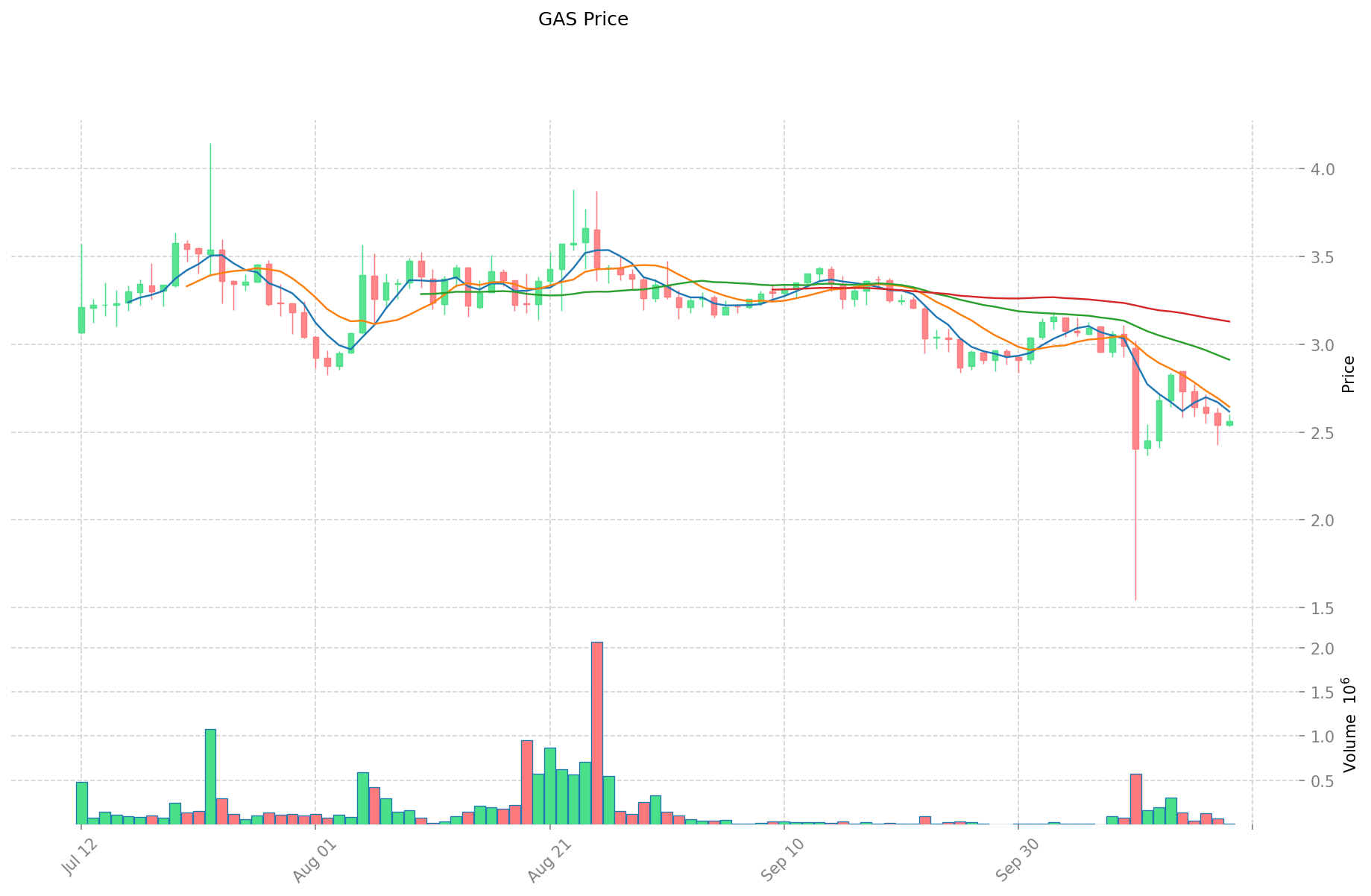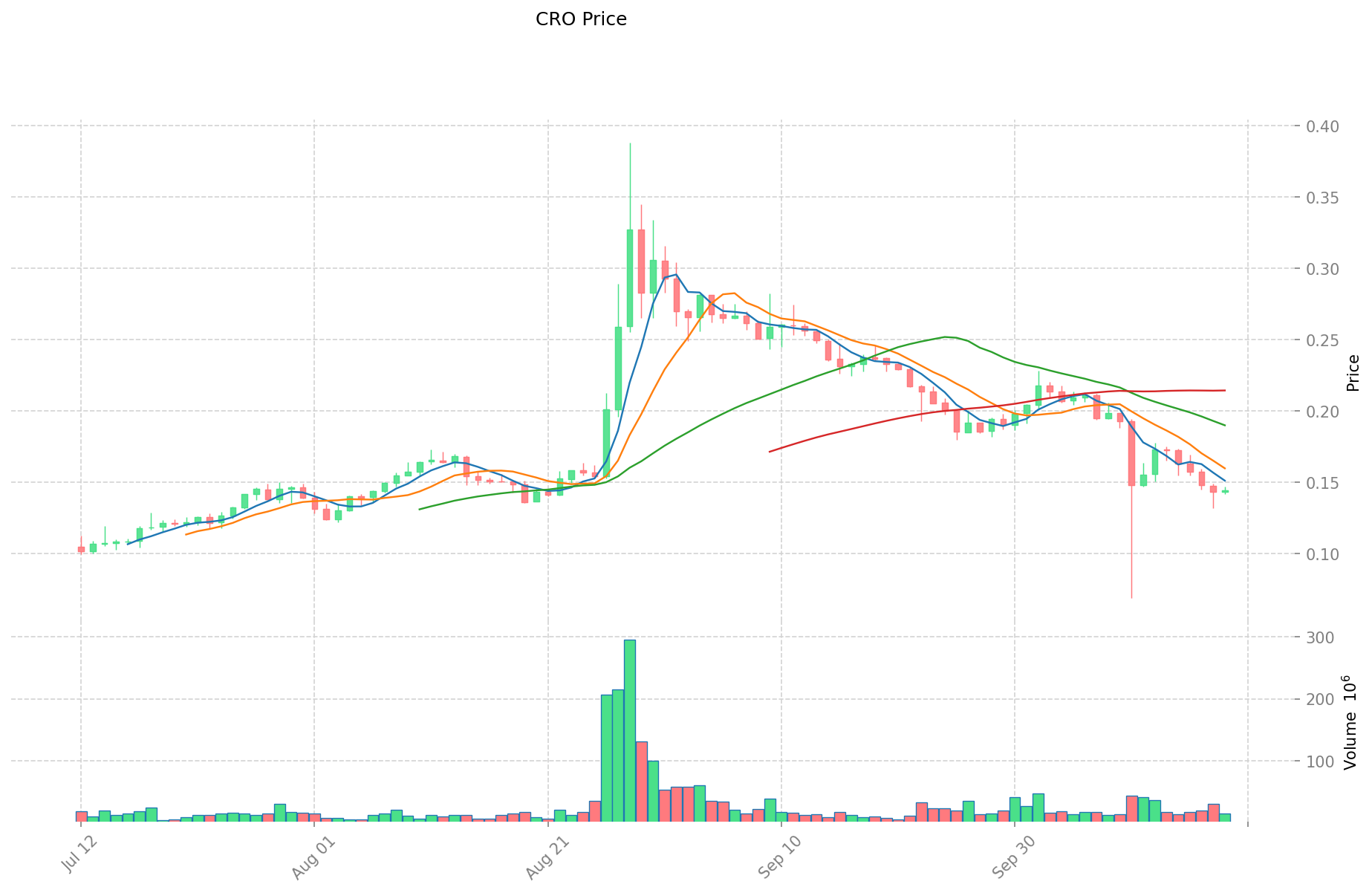GAS vs CRO: Which Cryptocurrency Offers Better Long-Term Growth Potential?
Introduction: GAS vs CRO Investment Comparison
In the cryptocurrency market, GAS vs CRO comparison has always been a topic that investors can't avoid. The two not only have significant differences in market cap ranking, application scenarios, and price performance, but also represent different cryptocurrency positioning.
GAS (GAS): Since its launch in 2017, it has gained market recognition as the fuel token for the NEO blockchain network.
CRO (CRO): Introduced in 2018, it has been hailed as a leading blockchain ecosystem token, representing a key part of the Crypto.com platform and Cronos network.
This article will comprehensively analyze the investment value comparison between GAS and CRO, focusing on historical price trends, supply mechanisms, institutional adoption, technical ecosystems, and future predictions, and attempt to answer the question that investors are most concerned about:
"Which is the better buy right now?"
I. Price History Comparison and Current Market Status
GAS (Coin A) and CRO (Coin B) Historical Price Trends
- 2018: GAS reached its all-time high of $91.94 on January 15, 2018.
- 2020: GAS hit its all-time low of $0.621309 on March 13, 2020.
- 2021: CRO achieved its all-time high of $0.965407 on November 24, 2021.
- 2019: CRO recorded its all-time low of $0.0121196 on February 8, 2019.
Comparative analysis: During market cycles, GAS experienced a significant drop from its high of $91.94 to a low of $0.621309, while CRO showed remarkable growth from its low of $0.0121196 to a high of $0.965407.
Current Market Situation (2025-10-19)
- GAS current price: $2.558
- CRO current price: $0.14418
- 24-hour trading volume: GAS $37,006.992504 vs CRO $2,076,690.991934
- Market Sentiment Index (Fear & Greed Index): 23 (Extreme Fear)
Click to view real-time prices:
- View GAS current price Market Price
- View CRO current price Market Price


II. Core Factors Affecting the Investment Value of GAS vs CRO
Supply Mechanisms Comparison (Tokenomics)
- GAS: Fixed supply with a maximum cap of 100 million tokens, making it a scarce digital asset
- CRO: Total supply of 30 billion tokens with burning mechanisms, including an initial 70 billion token burn in February 2021
- 📌 Historical pattern: Fixed supply tokens like GAS tend to increase in value during market uptrends due to scarcity, while CRO's value is influenced by its utility within the Crypto.com ecosystem and periodic token burns.
Institutional Adoption and Market Applications
- Institutional holdings: CRO appears to have stronger institutional backing through Crypto.com's partnerships with Visa and various sports organizations
- Enterprise adoption: CRO has wider payment applications through Crypto.com Pay and the Visa card program, while GAS is primarily used for transaction fees within the NEO ecosystem
- Regulatory attitudes: Both tokens face varying regulatory scrutiny across jurisdictions, with CRO benefiting from Crypto.com's efforts to obtain licenses in multiple countries
Technical Development and Ecosystem Building
- GAS technical upgrades: Serves as fuel for the NEO blockchain, with value tied to NEO's smart contract capabilities and N3 upgrades
- CRO technical development: Migration from Ethereum to its own Cronos chain based on Cosmos SDK, enabling lower fees and faster transactions
- Ecosystem comparison: CRO has a more diverse ecosystem spanning DeFi, payments, NFTs, and exchange services through the Crypto.com platform, while GAS is more limited to the NEO blockchain's functionality
Macroeconomic Factors and Market Cycles
- Performance in inflationary environments: GAS's fixed supply potentially offers better inflation resistance compared to CRO
- Macroeconomic monetary policies: Both tokens show correlation with broader crypto market responses to interest rate changes and USD strength
- Geopolitical factors: NEO and GAS may be influenced by Chinese regulatory policies, while CRO has more global exposure through Crypto.com's international presence
III. 2025-2030 Price Prediction: GAS vs CRO
Short-term Prediction (2025)
- GAS: Conservative $1.86 - $2.55 | Optimistic $2.55 - $3.42
- CRO: Conservative $0.10 - $0.14 | Optimistic $0.14 - $0.18
Mid-term Prediction (2027)
- GAS may enter a growth phase, with an estimated price range of $2.54 - $3.83
- CRO may enter a steady growth phase, with an estimated price range of $0.14 - $0.22
- Key drivers: Institutional capital inflow, ETFs, ecosystem development
Long-term Prediction (2030)
- GAS: Base scenario $2.52 - $4.43 | Optimistic scenario $4.43 - $4.78
- CRO: Base scenario $0.17 - $0.26 | Optimistic scenario $0.26 - $0.37
Disclaimer
GAS:
| 年份 | 预测最高价 | 预测平均价格 | 预测最低价 | 涨跌幅 |
|---|---|---|---|---|
| 2025 | 3.41968 | 2.552 | 1.86296 | 0 |
| 2026 | 4.180176 | 2.98584 | 2.1796632 | 16 |
| 2027 | 3.83381856 | 3.583008 | 2.54393568 | 40 |
| 2028 | 3.893833944 | 3.70841328 | 2.1879638352 | 44 |
| 2029 | 5.05549440396 | 3.801123612 | 3.38300001468 | 48 |
| 2030 | 4.7825737286184 | 4.42830900798 | 2.5241361345486 | 73 |
CRO:
| 年份 | 预测最高价 | 预测平均价格 | 预测最低价 | 涨跌幅 |
|---|---|---|---|---|
| 2025 | 0.1811502 | 0.14377 | 0.0992013 | 0 |
| 2026 | 0.177081509 | 0.1624601 | 0.12996808 | 12 |
| 2027 | 0.22070204585 | 0.1697708045 | 0.1358166436 | 17 |
| 2028 | 0.27137863099325 | 0.195236425175 | 0.11518949085325 | 35 |
| 2029 | 0.277635958420108 | 0.233307528084125 | 0.202977549433188 | 61 |
| 2030 | 0.365324592850527 | 0.255471743252116 | 0.166056633113875 | 77 |
IV. Investment Strategy Comparison: GAS vs CRO
Long-term vs Short-term Investment Strategies
- GAS: Suitable for investors focused on blockchain infrastructure and potential ecosystem growth
- CRO: Suitable for investors interested in payment solutions and diverse crypto ecosystem exposure
Risk Management and Asset Allocation
- Conservative investors: GAS: 30% vs CRO: 70%
- Aggressive investors: GAS: 60% vs CRO: 40%
- Hedging tools: Stablecoin allocation, options, cross-currency portfolios
V. Potential Risk Comparison
Market Risks
- GAS: High volatility due to smaller market cap and lower liquidity
- CRO: Exposure to broader crypto market fluctuations and competition in the exchange token sector
Technical Risks
- GAS: Scalability, network stability
- CRO: Centralization concerns, potential security vulnerabilities in the Crypto.com ecosystem
Regulatory Risks
- Global regulatory policies may have differing impacts on both tokens, with CRO potentially facing more scrutiny due to its wider range of services
VI. Conclusion: Which Is the Better Buy?
📌 Investment Value Summary:
- GAS advantages: Fixed supply, potential for appreciation in NEO ecosystem growth
- CRO advantages: Wider adoption through Crypto.com platform, diverse use cases
✅ Investment Advice:
- New investors: Consider a balanced approach with a higher allocation to CRO due to its broader ecosystem and easier accessibility
- Experienced investors: Explore a diversified portfolio including both tokens, with allocation based on risk tolerance and market outlook
- Institutional investors: Conduct thorough due diligence on both projects, considering CRO for its institutional partnerships and GAS for potential blockchain infrastructure exposure
⚠️ Risk Warning: The cryptocurrency market is highly volatile, and this article does not constitute investment advice. None
VII. FAQ
Q1: What are the main differences between GAS and CRO? A: GAS is the fuel token for the NEO blockchain with a fixed supply of 100 million, while CRO is the token of the Crypto.com ecosystem with a total supply of 30 billion and burning mechanisms. GAS is primarily used for transaction fees within NEO, whereas CRO has wider applications in payments, DeFi, and exchange services.
Q2: Which token has shown better price performance historically? A: CRO has shown more significant price growth, rising from an all-time low of $0.0121196 in 2019 to an all-time high of $0.965407 in 2021. GAS, on the other hand, experienced a substantial drop from its all-time high of $91.94 in 2018 to a low of $0.621309 in 2020.
Q3: How do the supply mechanisms of GAS and CRO differ? A: GAS has a fixed supply with a maximum cap of 100 million tokens, making it a scarce digital asset. CRO has a total supply of 30 billion tokens with burning mechanisms, including an initial 70 billion token burn in February 2021.
Q4: Which token has stronger institutional adoption? A: CRO appears to have stronger institutional backing through Crypto.com's partnerships with Visa and various sports organizations. It also has wider payment applications through Crypto.com Pay and the Visa card program.
Q5: How do the ecosystems of GAS and CRO compare? A: CRO has a more diverse ecosystem spanning DeFi, payments, NFTs, and exchange services through the Crypto.com platform. GAS is more limited to the NEO blockchain's functionality and smart contract capabilities.
Q6: What are the long-term price predictions for GAS and CRO by 2030? A: For GAS, the base scenario predicts a range of $2.52 - $4.43, with an optimistic scenario of $4.43 - $4.78. For CRO, the base scenario predicts a range of $0.17 - $0.26, with an optimistic scenario of $0.26 - $0.37.
Q7: How should investors allocate their portfolios between GAS and CRO? A: Conservative investors might consider allocating 30% to GAS and 70% to CRO, while aggressive investors might opt for 60% GAS and 40% CRO. However, individual allocation should be based on personal risk tolerance and market outlook.
Share
Content